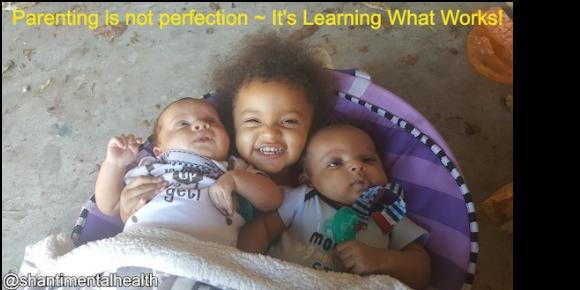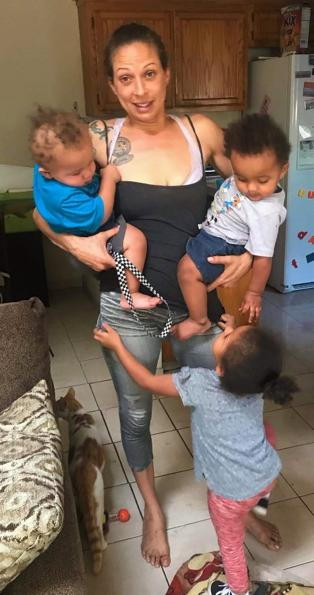
I originally wrote the book, Learning What Works: Discovering Your Baby and Yourself, in response to how I managed to attach to all three of my little ones under the age of two. I had the normal worries of “how am I going to balance meeting all three of their needs as well as my own?” The book is specific to an individual child; meaning I kept the domains of sensory and temperament in mind when meeting the needs of all three individual children. Meeting each of their individual needs promotes the opportunity for all of them to meet their psychosocial milestone of developing trust. Knowing and understanding what their individual needs can be called attunement.
Attunement is the basis of a healthy attachment.
When there are multiple children in the home, there may be different needs arising that may not arise with only one child in the home. The increased need for frustration tolerance is the biggest need that I saw that all my children needed. My 19-month-old was used to the co-regulation that I was consistently able to give her as a stay at home mom. As the co-regulation changed, there was an increase in tantrums. She also communicated new needs for validation of her existence and importance to me after the twins were born. I breast fed my twins for 8 months and this was particularly hard for her. With having two newborns in the home I also had their needs to meet as well. I consciously paid attention to all their differences and similarities in the domains of sensory and temperament. I looked at all of them intently and noticed their different body languages and facial expressions. I used the process described in the book to attune to all three so that I was able to learn their needs and learn how to communicate to each one.
However, with all this attending, my anxiety never reduced. I received advice from family members and even strangers. “What am I doing wrong?” “My babies don’t understand why I’m not meeting their needs on demand and they are going to resent me.” “I can’t meet all their needs at once.” “None of this advice works.” “No one gets it.” “I’m failing as a mom.”, and on and on and on. I needed to value myself and rekindle my confidence that I am enough because I am still their world. We have all seen the various memes that say, “We need you to be OK mama!” I knew I had to include myself in the balance. I started to ask myself “What works for me?” And what works for me is listening to my intuition. My attunement allowed me to understand my babies’ individual needs, “so let me just meet them” I told myself. Self-talk can be a powerful coping skill!
It was unrealistic to have individual time with all three when it is only me at home during the day. So, we all just “hung out”. “Hanging out” made the days feel much more comfortable. As we moved along the day (with no set routine) I just allowed the babies to lead me to what their needs were at the time. One baby may need closeness, one may need interaction, one may need to eat. How did one need to be close? What interaction is developmentally appropriate for one? How did one need to eat? And what works for me?
| Advice | Working? For me? My baby? | What can work? | |
| Tandem feeding | No and no | Pumping for one and nursing one and alternating babies next feeding. | |
| Everyone eating at once | Yes and sometimes |
|
So, lets talk “hanging out”. When I am out with a group of friends, we all attend to each other’s needs simultaneously. This may look like 2 conversations at once, patience when one gets side railed in conversation, all going to the store for one person to buy something, etc. The key to balancing this friendship is patience, appreciation, care for one another, interests in the same things and frustration tolerance. So, I talked all day long, explaining what I was doing and why (in age appropriate language). My goal was to balance all their needs at once. However, we all just hang out together, learning to tolerate frustration, to care for each other, and enjoy activities and routines together. Are all my babies’ needs met on demand or all at once? No. Is that real life? Yes. Life can be real and healthy attachments can still form.
| Need | Challenge - hungry twins | The simultaneous balance |
| Oldest individual needs: to feel important to me, identification of things, developing 3-4-word sentences, climbing, manipulating objects, sharing, art experiences | Oldest having a tantrum when her brothers nurse | Talking to my daughter about how “hungry” feels and how her brothers eat (promoting care and empathy), giving her a hands-on activity and talking to her to assist her in waiting (developmental distractions), allowing her to hold my breast (like a bottle) while Twin B is nursing (making her feel valuable), Identifying and validating her feelings (promotion of frustration tolerance) and knowing which one she needed at which time (attunement) |
| Twin A individual needs: eating on demand, touching me to feel secure to interact in the world, tummy time, opportunities for language development (reading, singing, etc.), rocking, active play | Twin A is eating as if he missed a meal | No challenge there |
| Twin B individual needs: eating on demand, visual stimulation, tummy time, opportunities to grab things, singing (as opposed to reading) rocking, quietness | Twin B is having latching problems | Having a backup pumped bottle and holding it with one hand while twin B was in a chair and twin A was nursing. At times I supplemented if I could not meet my expectations of pumping. |
| My needs: to feel calm and confident | Feeling like this is impossible and my babies will suffer | Ignoring opinions about formula, ignoring opinions about breast feeding, focusing on how I respond to the eldest’s needs rather than how she expressed them (ignoring opinions about discipline), and knowing that as I balanced ALL of their needs that a healthy attachment can be developed (even if its not how I wanted or expected) |
Of course, feeding time would end. And I would continue to recognize needs and respond to them as they arise throughout their routine. Sometimes this looked like singing to twin B as he cried while I would bathe twin A. Of course, I would try visual stimulation, soft music, wrist rattles, anything to attend to his individual sensory or temperamental needs. But sometimes he just needed to express his frustrations (with waiting for me to pick him up) through crying. So, I would sing to him about bathing his brother while I would point out body parts to twin A. My oldest would have her bathing materials and baby doll and would join in the routine, telling her baby about their body parts as well.
This is how I attuned: I was intentional about singing to build frustration tolerance because I knew that twin B responds positively to singing. I was intentional about using this time to “dramatic play” with my daughter to reassure her importance to me. I was also intentional as I cleaned each body part in correlation with the song because twin A seeks out language interaction.
Sometimes the challenge is for yourself, such as all three babies crying at once. Don’t forget to attune to your self as well. Do you need self-talk? Music? Someone to talk to? My challenge was the noise level. I didn’t mind the crying if they would only cry softer. So, I needed to eliminate all other sounds in the home just to manage hearing all of their cries at once. Did I like this? No, Id rather listen to music or the news. However, I knew this was a sacrifice I had to make to stay regulated while they cried. I needed self-talk in order to sacrifice, “this is only temporary, I can listen to the news later, etc.”
Attunement also supports in having realistic expectations. Twin B has a slower development than twin A. Because I am attuned to their difference in development, I can have individual realistic expectations for them. This relieves my pressure of negative thoughts and frustration when one is not responding as the other. Attuning to my babies has also allowed me to recognize developmental delays and I was able to seek out services for twin B before 2 years old. Early intervention is always the best prevention for future delays. And, I can use this situation as another opportunity for my other two babies to grow emotionally. Furthermore, for myself, I can feel supported from the services I get and feel less frustration when going through my daily routine by avoiding unrealistic expectations for twin B.
Attunement does not come naturally for all parents. And at times it’s hard to recognize sensory and temperamental needs in our babies. For further support in developing attunement with your baby or babies, which is start of developing a healthy attachment, Learning What Works: Discovering your Baby and Yourself, is a great book to support.
